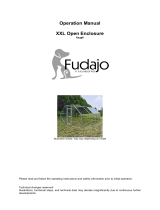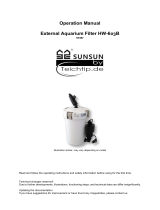Page is loading ...

Operation Manual
Incubator Lamp
50039–07
Similar to image, may vary depending on model
Read and follow the operating instructions and safety information before use.
Technical changes reserved!
Due to further developments, illustrations, functioning steps, and technical data can differ slightly.

© by WilTec Wildanger Technik GmbH Item 50039-07 Page 2
http://www.fudajo.com 08 2022-1
The information contained in this document may alter at any time without previous notice. It is prohibited
to copy or spread any parts of this document in any way without prior written allowance. All rights re-
served.
The WilTec Wildanger Technik GmbH cannot be held accountable for any possible mistakes in this
operating manual, nor in the diagrams and figures shown.
Even though, the WilTec Wildanger Technik GmbH has undergone biggest possible efforts to ensure
that the operating manual is complete, faultless, and up to date, mistakes cannot be entirely avoided.
If you should find a mistake or wish to make a suggestion for improvement, we look forward to hearing
from you.
Send an e-mail to:
or use our contact form:
https://www.wiltec.de/contacts/
The most recent version of this manual in various languages can be found in our online shop via:
https://www.wiltec.de/docsearch
Our postal address is:
WilTec Wildanger Technik GmbH
Königsbenden 12
52249 Eschweiler
Germany
E-mail: service@wiltec.info
Tel: +49 2403 55592–0
Fax: +49 2403 55592–15
To return orders for exchange, repair, or other purposes, please use the following address. Attention!
To allow for a smooth execution of your complaint or return, it is important to contact our customer
service team before returning the goods.
Returns Department
WilTec Wildanger Technik GmbH
Königsbenden 28
52249 Eschweiler
E-mail: service@wiltec.info
Tel: +49 2403 55592–0
Fax: +49 2403 55592–15

© by WilTec Wildanger Technik GmbH Item 50039-07 Page 3
http://www.fudajo.com 08 2022-1
Introduction
Thank you very much for buying this quality product. To reduce the risk of injury, we ask you to always
regard a few basic safety requirements, when using this product. Please thoroughly read the operating
manual and make sure that you have understood it.
Keep the operating manual for future reference.
This special incubator lamp for screening the inner part of the egg can be switched on and off via a
push button placed at the bottom part. We kindly request you to only use standard commercial batteries
(not included).
To succeed in the artificial breeding of the eggs, it is important to continuously observe the eggs.
Using this kind of lamp means simply screening the egg to illuminate it in a way that one can observe
the stage of its development. It makes sense to keep track of the respective stage of development by
recording the observations to keep track of the chick’s development. It is of great importance to recog-
nise any unfertilised or dead eggs as soon as possible and to immediately eliminate those because
there is the danger of fermentation gas in dead eggs which makes the affected eggs burst. This in turn
– in the worst case - affects the healthy eggs whose pores are clogged then. This means the dead of
the healthy chicks.
It is advisable to postpone the screening approximately until the 7th day, as the eggs are fairly sensitive
to temperature. By removing them from the incubator the fluctuations of temperature can have a nega-
tive impact on the breeding result. After the screening it is advisable to let the eggs rest until the 14th
day. On the 14th day it is recommended to check those eggs that have not shown a clear result on the
7th day.
As for the screening, it is advisable to set up a dark place nearby the incubator. Gently remove the
egg from the incubator and hold up the thick end of the egg (where there is the air bubble) directly
against the lamp. Now you fix the egg between thumb and forefinger at the pointed end of the egg and
slightly tilt it to one side. Then you keep turning the egg as long as it takes to have the perfect look
inside. The screening should take place without hesitation to make sure that the eggs can be returned
into the incubator within 20–30 min. By this means the process of breeding is not affect-ed by the screen-
ing.
Eggs whose embryos have been developed successfully have the following features:
– blood vessels spreading towards outside like a spider web from the centre of the egg
– the beating heart, a spot having a size of approximately 3 mm and remaining in a moving state
An unfertilised egg does not have any stains. The contents of a dead egg is immobile.
An embryo’s death during the breeding process makes a so-called “fairy ring” form. This red ring
sprouting on the inner side of the shell is due to the withdrawal of the blood vessels, lying against the
shell.
If there are no clear signs, it is advisable to mark the respective egg and to check it once more on the
14th day.
Any unfertilised egg that has been located in the incubator before is no longer suitable for consump-
tion.
Important note:
The reprint or reproduction, even of excerpts, and any commercial use, even in part of this instruction
manual requires the written permission of the WilTec Wildanger Technik GmbH.
/

